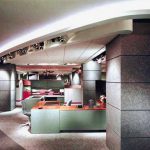 For several decades, healthcare organizations have been developing Centers of Excellence to better compete for market share, research dollars, philanthropy, and scarce subspecialists. Promoting a specific program within the healthcare organization’s broader portfolio of services helps to attract the critical mass and resources required to make it successful. Centers of Excellence are commonly developed for cardiac care, cancer treatment, neurosciences, orthopedics, pediatrics, and women’s health, although various other clinical programs and specialties may also be candidates. Historically, these centers were envisioned as freestanding facilities with the name prominently displayed on the building’s facade. Before high-speed internet and intranet connections, this concept was promoted to improve collaboration and communication among the healthcare providers as well as to provide one-stop-shopping for the customer.
For several decades, healthcare organizations have been developing Centers of Excellence to better compete for market share, research dollars, philanthropy, and scarce subspecialists. Promoting a specific program within the healthcare organization’s broader portfolio of services helps to attract the critical mass and resources required to make it successful. Centers of Excellence are commonly developed for cardiac care, cancer treatment, neurosciences, orthopedics, pediatrics, and women’s health, although various other clinical programs and specialties may also be candidates. Historically, these centers were envisioned as freestanding facilities with the name prominently displayed on the building’s facade. Before high-speed internet and intranet connections, this concept was promoted to improve collaboration and communication among the healthcare providers as well as to provide one-stop-shopping for the customer.
CURRENT TREND
Healthcare organizations are increasingly looking for more cost-effective ways to achieve a similar result while spending fewer capital dollars. To accomplish this, they are focusing on the specific elements that give customers the perception of arriving at the “center” or “hub” and then connecting the “spokes” — other functional components and services that may be connected either physically or electronically.
Unless the center is being constructed as a freestanding facility on a new site, some services could be located within existing space while others may be in a new addition. The trade-offs between the cost (both the initial capital investment and ongoing operational cost) of achieving physical adjacency, versus settling for less-than-perfect convenience for the customer, need to be reviewed and weighed carefully. The potential for increased revenue, reimbursement, and the demands of donors, partners, or investors may also impact the physical design. Unfortunately, physicians often have difficulty imagining a center that is not an imposing edifice or at least a freestanding building
HEART CENTER AS AN EXAMPLE
For example, a Heart Center may be developed on an existing hospital campus by creating a dedicated patient entrance that leads directly to the Heart Center reception desk and intake area, a comfortable lounge and resource center for patients and family members, and a conference room for group education on various aspects of heart disease. The new lobby may be used for health promotion and assessment activities, enrolling patients in clinical trials, and for fund raising. However, all other Heart Center components may be located within existing space and accessed via an elevator or a short walk down an adjacent corridor — including cardiologist and cardiac surgeon offices, non-invasive cardiac diagnostics, cardiac catheterization lab, cardiac rehabilitation, and other related services.
CONCLUSION
From the patients’ perspective, once they arrive at a well-identified entrance and are greeted by a friendly and competent receptionist, they are generally oblivious to where they are treated as long as signage is effective and they are not asked to walk a great distance. Using this hub-and-spoke approach can result in significant cost savings without compromising customer service.
